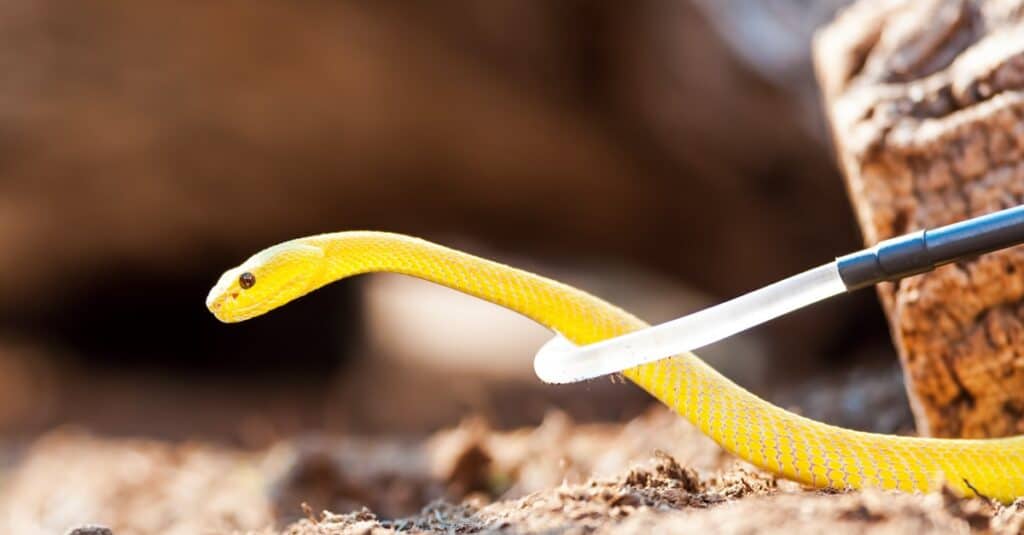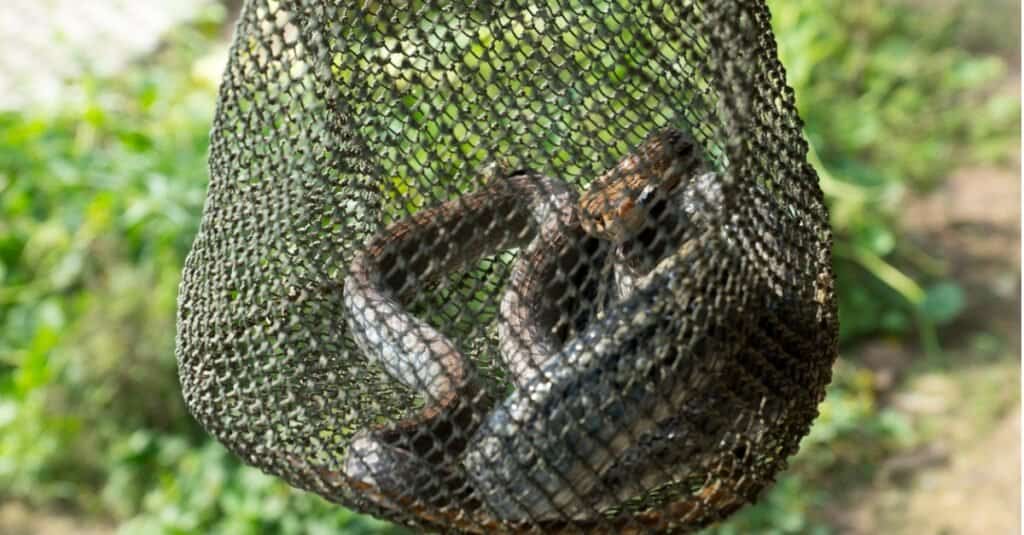Whether you hear an unmistakable hiss or manage to catch a glimpse of a silent, slithery creature, you’ll know when you’ve come across a snake.
There are a few reasons why you might want to catch it. One is for qualified research purposes, especially if you or someone else has experienced a bite or it’s an invasive species. Another is to get rid of a snake on your property, especially if it’s venomous or in the house. Last but not least is to keep a non-venomous snake, such as the garter snake, as a pet. However, before you capture a wild snake to keep as a pet, be sure you know your local laws and what a wild snake needs to acclimate to captivity.
Catching snakes can be tricky. So how do you decide whether you should even try? First, determine the danger level. Is it venomous?
Venomous or Not? Determining the Danger Level
Figuring out whether a snake is venomous depends on where you live. Some areas have vipers, others have elapids, and others have a little bit of everything. For this article, we’re focusing on North American snakes. So, nearly all the venomous snakes are pit vipers, plus a few coral snakes (elapids).
It can be hard to tell the difference between a venomous and a non-venomous snake. While some people say that all venomous snakes have big triangular heads, that’s not true. There are many venomous snakes that do not fit that profile. In addition, all snakes can flatten their head to appear bigger.
If you see these snakes and do not have the experience to safely remove them, call an expert. There are dozens of volunteer snake removal experts in most areas, in addition to paid services.
Rattlesnakes
In North America, the venomous snake you’re most likely to encounter is a rattlesnake. There are two groups of these venomous pit vipers. One group has tiny little scales all over their heads, and the other, known as pygmy rattlesnakes or massasaugas, have several large scales on the front half of their head. In both cases, they either have rattles or a button where a rattle will develop.
Most rattlesnakes have heads that are very large in comparison with their neck, big burly bodies, and strongly keeled scales. Most of them average between two and seven feet long. These are snakes that try to warn you with a rattle if you’re too close. But they don’t always rattle because they’ve either been surprised or aren’t old enough to have any rattles on that tail button.
There are a couple of other pit vipers that may make their way into your home or yard, and you absolutely must be able to identify them! They don’t have rattles and are close cousins. If you live anywhere in the south or southeastern United States, you know these snakes.
Copperheads and Cottonmouths
They’re heavy-bodied pit vipers, like the rattlers, but they aren’t rattlesnakes. Copperheads cause almost half of the venomous snakebites in the U.S. yearly, so knowing how they look is vital. This species is usually two or three feet long, heavy-bodied, and most have a chocolate kiss pattern of darker markings over a lighter tan or even pink base color. They have copper-colored heads, hence their name.
Cottonmouths are also called water moccasins. They’re easily the most feared venomous snake in the South. However, they’re not the aggressive monster that most people claim. Cottonmouths stand their ground. Instead of slithering off like other snakes, they coil up and stay put, often displaying their white-colored mouths by popping them open. Like the others, their scales are keeled; they have big, heavy bodies, and wedge-shaped heads on a thinner neck. However, they also have a dark stripe beginning right behind their eye.
Coral Snakes
These highly venomous cobra cousins are extremely shy! Many people who live within their range can go a lifetime without seeing a single one of these outside of a zoo. However, they crop up occasionally, so they deserve a mention.
Coral snakes are tube-shaped snakes with a black snout and a thick yellow or white band behind their eyes. They’re only about two feet long and most U.S. coral snakes (not all, so we won’t be discussing the merits of the rhyme here) have alternating bands of red and black, separated by a bright yellow or white band. Eastern and Texas coral snakes almost always have yellow, but the Arizona species varies from pale yellow to off-white or cream. Coral snake bands encircle the snake’s belly and body, unlike most of the nonvenomous look-alikes.
How to Catch a Snake in the House

©iStock.com/adogslifephoto
Snakes are typically shy of humans and normally do not enter houses. However, they may seek shelter in extreme weather or, in the case of rat snakes, if you have a rodent infestation.
For snakes in the house, if it’s not venomous, you can gently pick them up with your hands or sweep them gently into a bucket or waste bin. Snakes are far more delicate than most realize and are often injured by pinching them behind the head by unskilled people.
For venomous snakes, if you absolutely must catch it and can’t get someone out or purchase a snake trap, you have a couple of options, but they can be risky.
Snake Tongs
One is to use snake tongs if you know how to use them and place the snake into a deep bucket or trashcan that has a tight-fitting lid. Another is to use a mosquito net or pool net attached to a long broom handle. Ensure the handle is long enough to catch the snake safely and the net is big enough to fit the snake in. Put the net in front of its head and have someone else encourage it to slither inside with a broom.
Snake Hook
A snake hook is also a great choice for catching snakes of all kinds. However, the cheap telescoping hooks are no good for heavier snakes. Get a good one and have a bucket or trashcan ready.
Take the hook end and gently scoop under the snake’s body, allowing it to slither over the top of the hook. Then you can lift slowly, while moving it toward the bucket.
How to Catch a Snake in Your Yard
If you have a snake in your yard, it’s not as bad compared to in the house, but it can limit your movement if it’s venomous. Simply trim the bushes, mow the grass, or clear the junk pile, and they’ll probably move out on their own!
You can also use your garden hose! Gently spray the snake to encourage them to move on. They really don’t enjoy being squirted, and most are happy to cooperate.
How to Catch a Snake in the Wild
Catching a snake in the wild is the most difficult method because that’s where the snake can hide the easiest. You’ll need to know how to find it safely in the first place because you can’t know whether the snake is venomous until you come across it and get a good look. It takes time and a good eye to be able to tell where a snake has set up its home or is resting. Here are a few signs:
- Scent: Many snakes emit a strong odor when threatened.
- Tracks: Slithering trails on the ground tell you where the snake has traveled.
- Snakeskin: Snakes periodically shed their skin, which resembles its physical form.
- Snake holes: Snakes can’t burrow, so they repurpose holes by other animals in the ground or in trees. Look for tracks, feces, and/or snakeskin around it.
Once you’ve found the snake or its den, you can use any one of several methods to catch it. Methods such as snake tongs and a bucket, a mosquito net attached to a long handle, a snake trap, or either of the DIY traps below will work.

©Tuttoo/Shutterstock.com
How to Catch a Snake Barehanded
Being able to catch a venomous snake barehanded is a skill that takes a lot of practice. Probably years. We do not recommend trying to barehand a venomous snake. Ever. On the other hand, if the snake is nonvenomous, you can pick it up near the mid-body with your hands held flat. The best way to hold a snake is to let it slither over your hands by moving one hand at a time into position.
There are a few different reasons for wanting to catch a snake. Snakes can be useful as pest control, but some are a threat to your family’s safety. They may be desirable to catch for research or to keep the non-venomous ones as pets. Regardless of your reason, it’s important to know how to do so safely.
Up Next…
- Garter Snake These are beneficial snakes that eat insects, small frogs, snails, etc. They are shy and generally harmless to humans and pets. Learn more about them here.
- Rattlesnake If you live in the arid regions of the country, chances are you will encounter a rattlesnake at some point. Learn more about them here so you will know how to live in their environment.
- Venomous vs Non-Venomous Snake: What’s the Difference? Learn how to tell the difference between venomous and non-venomous snakes so you can handle them safely.
The photo featured at the top of this post is © iStock.com/Maria Khomiakova
Discover the "Monster" Snake 5X Bigger than an Anaconda
Every day A-Z Animals sends out some of the most incredible facts in the world from our free newsletter. Want to discover the 10 most beautiful snakes in the world, a "snake island" where you're never more than 3 feet from danger, or a "monster" snake 5X larger than an anaconda? Then sign up right now and you'll start receiving our daily newsletter absolutely free.
Thank you for reading! Have some feedback for us? Contact the AZ Animals editorial team.






